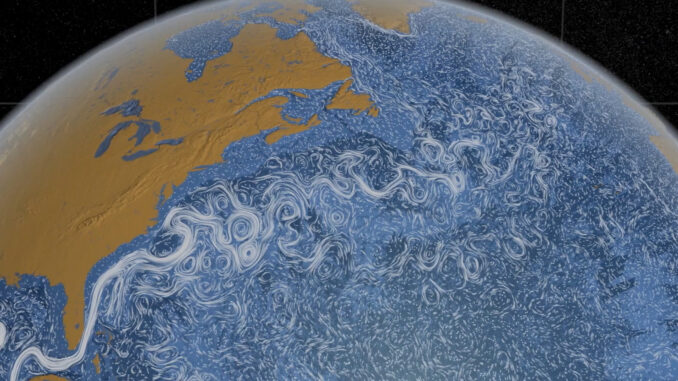
Remember the Younger Dryas
by Jess Spear
Don’t you know the climate has changed in the past? Sure, all that’s happening now is natural climate change. We’ve nothing to worry about.
Fifteen thousand years ago the earth was just coming out its last ice age. Sunlight poured into the Northern Hemisphere and atmospheric greenhouse gases were rapidly increasing. Massive ice sheets that had advanced over North America and Scandinavia during the preceding 100,000 years were receding rapidly, raising global sea level by hundreds of metres.
Then all of a sudden, Europe was plunged back into an ice age. Temperatures plummeted, mountain glaciers started to grow again and cold-loving plants, like the Dryas octopetala, flourished. The frigid conditions would persist for 2,000 years before warming resumed and the earth fully emerged from the ice age.
The main suspect for this abrupt climate event was gargantuan amounts of freshwater pouring off the melting ice sheets, a.k.a. “meltwater”. Essentially, global warming triggered a mini-ice age known as the Younger Dryas (after the alpine flower that returned to the area).
How exactly could a melting ice sheet trigger an ice age, you might ask? By switching off the heat.
The Great Ocean Conveyor Belt
The ocean is not one big tub of water, with uniform temperature and salt content. It’s separated into thousands of currents that act like one giant conveyor belt, transporting heat, salt, and nutrients around the earth (Image 1). On the top portion of the belt, warm surface currents (like the Gulf Stream in the Atlantic) travel from the equator towards the poles.
As the warm, salty Gulf Stream waters make their way north, water evaporates and heat is released to the air (helping to warm Ireland and Britain). This process makes the current increasingly saltier and therefore denser and heavier than the surrounding seawater. When it reaches the cold North Atlantic off the coast of Greenland, the very salty-surface current chills rapidly and sinks to form the lower part of the conveyor belt, the North Atlantic Deep Water. The deepwater travels back south and beyond. And on and on the belt turns, distributing heat. Until it doesn’t.
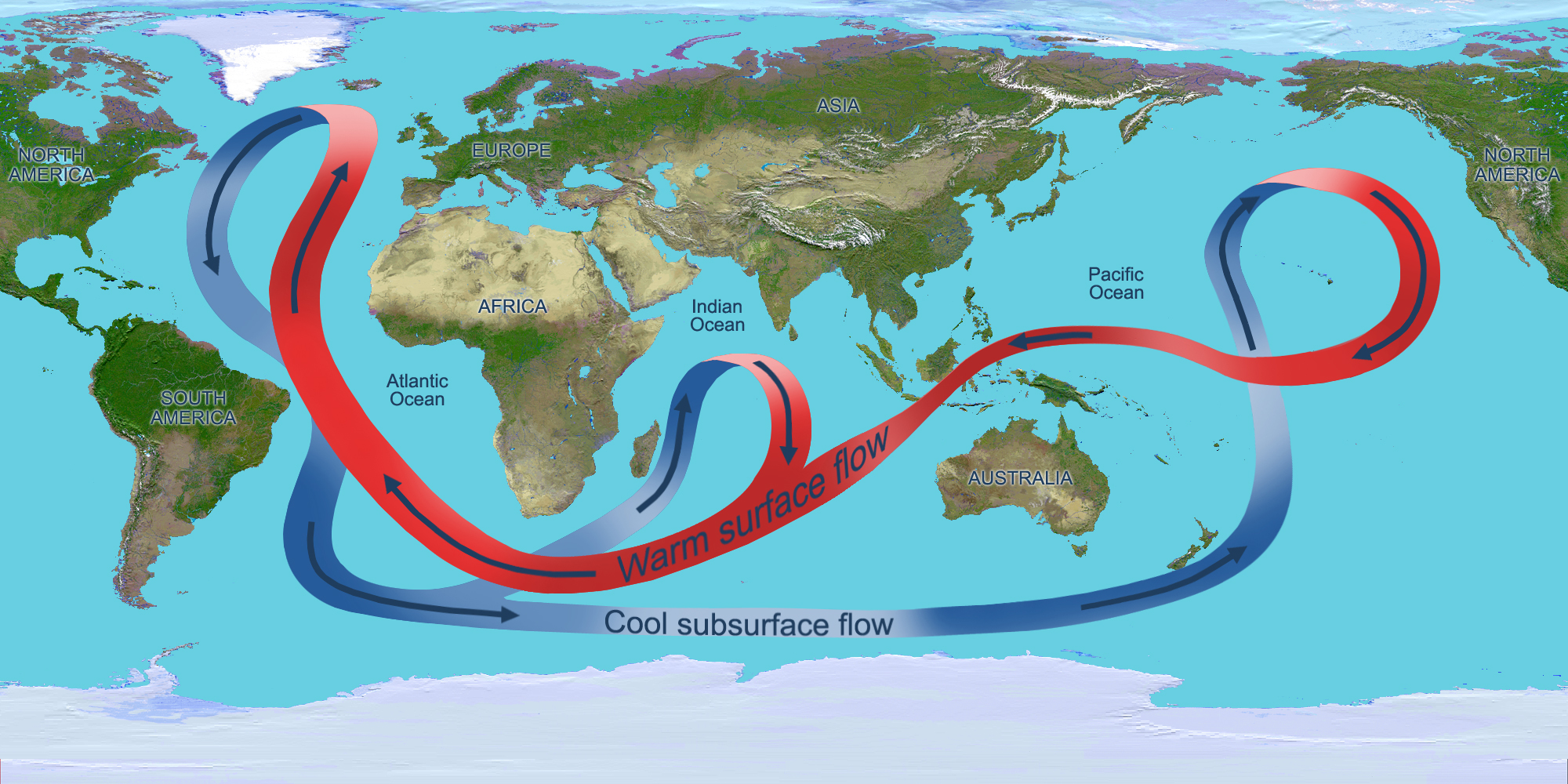
Ice has no salt in it. It’s made of freshwater (99% of all the freshwater on earth is stored in ice sheets) and therefore its meltwater is lighter than the saltwater in the ocean. If you pour enough meltwater onto the ocean conveyor, right where the deep water is forming, right where the salty water is sinking, effectively diluting the surface current, you stop the ocean conveyor belt. You switch off the heat.
Ice Age Wobble
Over the last 2.6 million years the earth has gone in and out of ice ages. The main factor driving the growth and decay of ice sheets is sunlight, and the amount of sunlight we receive is controlled by changes in the earth’s orbit.
We all know the earth is traveling around the sun. But reality is actually much more dynamic than that. The earth moves around like a spinning top, moving now closer, now further away from the sun in three different ways.
Firstly, over 100,000 years the path we take around the sun, the shape of our annual orbit, ranges from circular to elliptical (oval shaped) (Image 2). A circular orbit means we’re closer to the sun and get more sunlight and more heat. An elliptical orbit means less sunlight and less heat. (Fun fact: this is caused by the gravity of Jupiter and Saturn.)
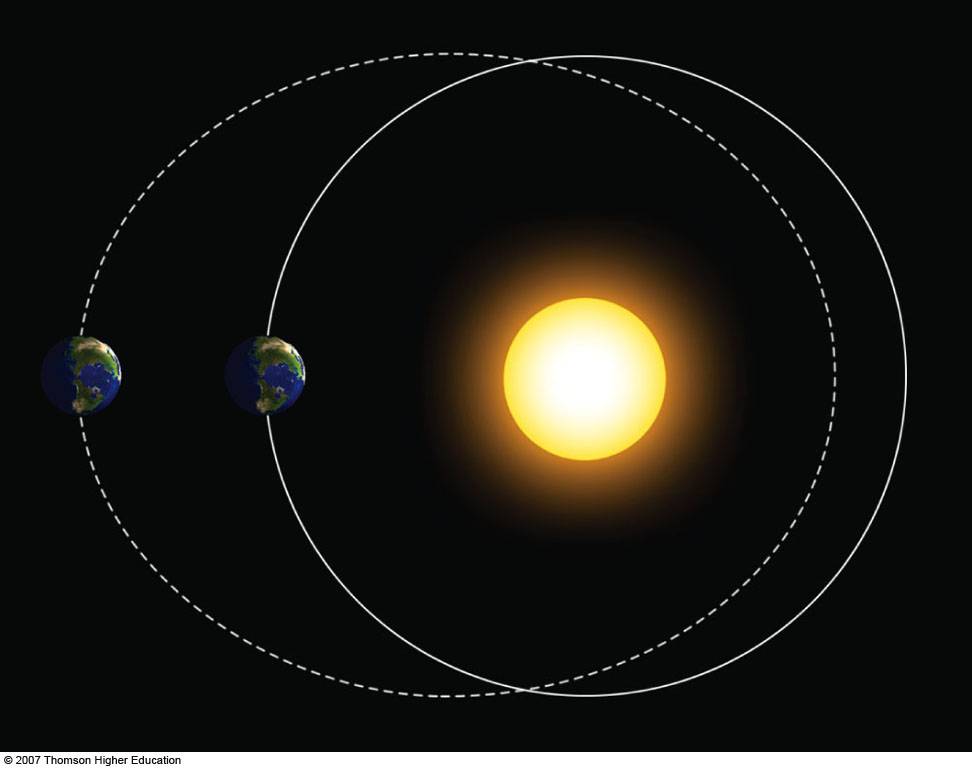
Secondly, as the earth rotates (at a speed of 107,000 km/h!) we are also wobbling very slowly as we orbit the sun. This wobble affects the amount of sunlight we receive in two ways, the tilt of the planet and what star the North Pole points at. If you think of the earth’s head as the North Pole and it’s feet the South Pole, the tilt is sort of like leaning forward a bit. As we go round the sun, the North Pole is “leaning” towards the sun, rather than just standing upright.
This is why we have seasons (Image 3). When the northern hemisphere is pointing towards the sun, it’s summer in Ireland, when it’s pointed away from the sun, it’s winter here (and the opposite for the southern hemisphere). Over 41,000 years, the earth’s tilt goes from around 22 to 24 degrees. In other words, the earth “leans” its “head” more or less towards the sun. The greater the degree of tilt, the more the earth “leans” towards the sun, the hotter the summers and the colder the winters.
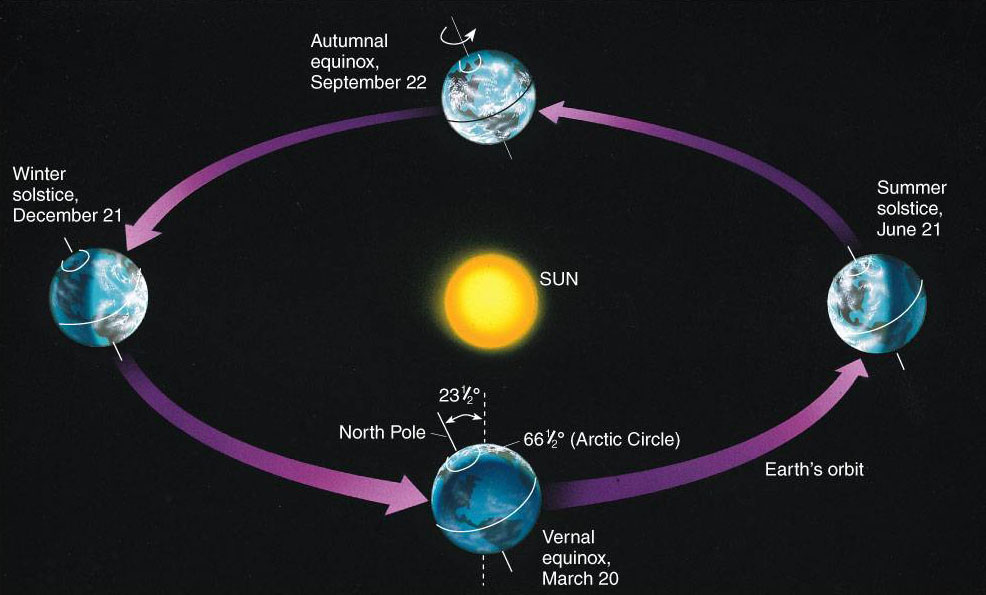
Thirdly, what is our north star? Where is the North Pole pointing? The answer depends on when you’re asking! Right now, the North Pole is pointing at Polaris, and towards the sun, but 13,000 years ago it was pointing in the opposite direction at Vega (Image 4). As with the other orbital shifts, where the North Pole points equates to more or less sunlight in the northern hemisphere. (Since there is more land in the northern hemisphere, there is more opportunity for ice sheets to grow there and for an ice age to develop.)
Fifteen thousand years ago, our wobbly orbit aligned to maximise the amount of sunlight we received. But after about 2,000 years of warming, the melting ice sheets caused what climate scientists call a “feedback loop”, a response within the climate system which can amplify the current trend (positive feedback) or disrupt it (negative feedback). For example, global warming melts the Arctic sea ice, less ice means less reflection of sunlight and more heat absorbed, which then melts more ice. Around 13,000 years ago, the rapidly melting ice sheets triggered a negative feedback — shutdown of the ocean conveyor belt..
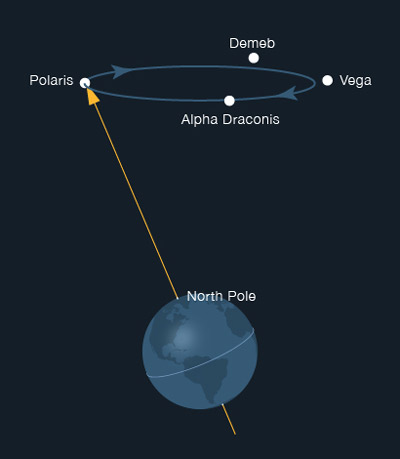
The day after tomorrow
Today, we also have global warming. This warming is not caused by changes in earth’s orbit, and it’s not happening slowly over the 10,000 years it took to exit the last ice age and enter the current warm period. It’s happening over roughly 200 years. The main culprit is increased atmospheric greenhouse gases from the unearthing and burning of fossil fuels. Fossil fuels themselves are basically ancient sunlight stored in microscopic plants which were cooked via immense heat and pressure into oil and gas. Burning fossil fuels is like leaning closer to the sun.
Ninety percent of the heat trapped by burning fossil fuels has gone into the oceans. This has caused a doubling of marine heatwaves since 1982. Much like the heatwaves hitting Europe every summer, big parts of the ocean are also feeling that. And, the more heat in the oceans, the bigger the storms. Hurricanes and cyclones, which feed off the warmer ocean temperatures and increased moisture in the air, have become supercharged monsters with deadly consequences.
The heat in the ocean is also melting the ice sheets.
We’ve got two big ice sheets. Along with the seasonal sea ice that forms in the Arctic Ocean and in the Southern Ocean off the coast of Antarctica, they’re kind of like earth’s air conditioners, keeping us cooler than we’d be otherwise. Their white surface reflects sunlight back into space and, well, they’re ice, so they cool the area around them.
In Greenland the ice sheet is roughly 2 km thick and, if all of it melted, contains enough water to raise sea level by 6 metres. Antarctica’s ice sheet is much, much bigger (roughly 6 times bigger). It too is about 2.5 km thick, but spread out over a land mass bigger than the United States. It holds enough water to raise sea level by a whopping 60 metres.
Both ice sheets are melting. A lot. They’re actually heading towards collapse. In other words, gone. If nothing changes, if we just continue burning oil and gas with wild abandon, pumping out more greenhouse gases, and trapping more and more heat, the ocean is going to rise. We are going to lose a lot of coastal cities. Small island nations are going to drown.
Yes, it will likely take centuries for the entire process to unfold, but it could happen a hell of a lot quicker than we anticipate. It’s not just the hot air. Because the ice is so thick and so heavy, it actually depresses the land beneath it. In some areas of West Antarctica the ice sheet sits a full 2 km below sea level. It’s the same with Greenland’s ice sheet. This allows the relatively (and increasingly) warmer water to attack it from below. Seawater can also act like a lubricant, slipping between the rock on which the ice sheet is grounded (or attached) and the ice sheet itself, helping break off huge chunks of ice.
So, we shouldn’t rest easy that it’ll just be a problem for the future. Seven hundred million people will need to relocate.
But remember, melting ice sheets threaten more than coastal cities and small island nations. They can shut down our ocean conveyor belt. They can switch off the heat.
The idea that meltwater from the Greenland ice sheet could trigger an ice age was popularised by the movie, The Day After Tomorrow. However, unlike what’s depicted in the movie, a shutdown of the ocean conveyor is extremely unlikely to occur in one day, and an ice age isn’t going to develop the day after. Instead, it will likely slow down over time until it reaches a tipping point and shuts down completely.
We know that Greenland is melting now. We also know that the meltwater is pouring into the area where deepwater forms the lower limb of the conveyor belt. So, what’s been the effect so far?
Not good, is the short answer. If the conveyor was slowing, you’d expect to see less heat transported to the north and a buildup of heat just south of that. And, that’s exactly what has been happening. The “fingerprint” of a slowing conveyor was detected by scientists in 2018: colder surface waters in the North Atlantic near Greenland, and warming along the east coast of the US. Scientists think the slowdown is roughly 15% of the “normal” rate. But really we just don’t know enough to say what the normal rate is, how variable it is over time, all the factors that go into that variability, and so on. We’re working on it though.
What we do know is the Younger Dryas happened. We weren’t around of course, so we can’t say precisely and exactly how the abrupt reversal to ice age conditions happened. But, we’re also not working in the dark. Big changes in climate leave their mark on the earth, in the trees, the fossils, in the ice, and in the soil. We can even detect the strength of the lower limb of the conveyor belt by looking at the fossil remains of animals in the ocean. After looking at multiple sources of evidence, scientists are pretty certain that the cause of the Younger Dryas was the shut down of the ocean conveyor system in the Atlantic.
We can’t know for sure what would happen if the ocean conveyor slowed further or shut down completely today or in the future. Colder winters are likely, as are more intense storms and deadly heat waves during summer.
Anything but “normal”
Capitalism has dumped so much carbon into the atmosphere, we’re beyond the “normal” range of variability of the past. Over the last 800,000 years the CO2 concentration never went higher than 300 ppm (parts per million, meaning for every one million air molecules 300 are CO2). We know this because the ice sheets themselves have trapped ancient air bubbles that we’ve analysed. Today we are at 416 ppm and climbing at a rate of around 2.3 ppm a year, 60 times faster than during the end of the last ice age.
Already ice sheets are melting and heading towards collapse with just 1 degree increase in global average temperature. We’re currently on track to see a further 3-4 degrees warming by the end of the century. This is anything but “normal” climate change.
The Younger Dryas is a reminder that climate change now and in the future will not be a linear, slow process. It will be chaotic, with potentially devastating consequences.
So, when climate change deniers use past climate change as evidence that current climate change is no big deal, our response is this. It is precisely past climate change, and in particular abrupt climate change, that makes climate scientists so anxious and fearful of what’s happening now.
Jess Spear is a paleo-oceanographer, editor of Rupture – an ecosocialist quarterly and activist with RISE in Ireland .


Be the first to comment